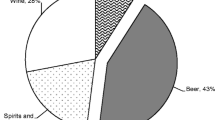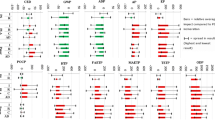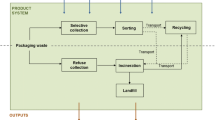Abstract
This article aims at comparing the environmental performance of single-use and multiple use beer cups at festivals. A life cycle assessment is conducted for assessing the potential environmental impacts of 1000 servings of 0.5 l of beer at Norwegian festivals. Three single-use systems are considered: one with incineration, one with open loop recycling, and one with closed loop recycling. The two first single-use systems and the reuse system assume the use of PP cups, while the latter uses PET cups, as PET is the only plastic material which currently allows a closed loop recycling system. Existing literature has shown that the choice of system depends on several site-specific parameters such as the definition of the trip rate in a reuse system and on the festival participant’s behaviour. In this article, we calculate the trip rate in the reuse system based on the cup return rates, which varies between all systems. The return rate was calculated using empirical data for Norway’s largest festival. In addition, the recycling stage is modelled with both cut-off and system expansion for assessing the robustness of the results. To reduce environmental impacts related to the serving of beers, festivals are advised to get an overview of the flows of the cups after use, to measure and limit their waste, and to have good collection systems for handling the cups as intended. The results of this study show that this is more important than the choice of cup material. LCA practitioners should be cautious with the implications of the end-of-life modelling approach on the results.









Similar content being viewed by others
Data Availability
The used data not presented in the paper is available from the authors upon request.
Code Availability
Not applicable.
References
Hanke G (2016) Marine Beach Litter in Europe – Top Items A short draft summary. In: REPORTS, J. R. C. T. (ed.).
UNEP (2021) Single-use beverage cups and their alternatives - recommendations from Life Cycle Assessments
Joint Research Centre (2016) Harm caused by Marine Litter
Kleiva Møller I, Comtet M, Rugaas MH (2019) Gjenbruksglass på festival - fra bruk og kast til bruk og vask. . In: PROSJEKTOPPGAVE (ed.). Handelshøyskolen BI
Coelho PM, Corona B, Ten Klooster R, Worrell E (2020) Sustainability of reusable packaging–Current situation and trends. Resources, Conservation & Recycling: X, 6
Mahmoudi M, Parviziomran I (2020) Reusable packaging in supply chains: a review of environmental and economic impacts, logistics system designs, and operations management. Int J Prod Econ, 228
Amienyo D, Azapagic A (2016) Life cycle environmental impacts and costs of beer production and consumption in the UK. Int J Life Cycle Assess 21:492–509
Amienyo D, Gujba H, Stichnothe H, Azapagic A (2012) Life cycle environmental impacts of carbonated soft drinks. Int J Life Cycle Assess 18:77–92
Pasqualino J, Meneses M, Castells F (2011) The carbon footprint and energy consumption of beverage packaging selection and disposal. J Food Eng 103:357–365
Simon B, Amor MB, Földényi R (2016) Life cycle impact assessment of beverage packaging systems: focus on the collection of post-consumer bottles. J Clean Prod 112:238–248
Van Der Harst E, Potting J (2013) A critical comparison of ten disposable cup LCAs. Environ Impact Assess Rev 43:86–96
Van Der Harst E, Potting J, Kroeze C (2014) Multiple data sets and modelling choices in a comparative LCA of disposable beverage cups. Sci Total Environ 494–495:129–143
Almeida J, Bengtsson E (2018) Reusable coffee cups life cycle assessment and benchmark.
CUPCLUB (2018) Join the reusable revolution: CupClub Sustainability Report 2018 A comparative Life Cycle Assessment (LCA) of 12oz CupClub cup and lid
Foteinis S (2020) How small daily choices play a huge role in climate change: the disposable paper cup environmental bane. J Clean Prod, 255
VTT (2019) Taking a closer look at paper cups for coffee
Woods L, Bakshi BR (2014) Reusable vs. disposable cups revisited: guidance in life cycle comparisons addressing scenario, model, and parameter uncertainties for the US consumer. Int J Life Cycle Assess 19:931–940
Changwichan K, Gheewala SH (2020) Choice of materials for takeaway beverage cups towards a circular economy. Sustain Prod Consum 22:34–44
Vercalsteren A, Spirinckx C, Geerken T (2010) Life cycle assessment and eco-efficiency analysis of drinking cups used at public events. Int J Life Cycle Assess 15:221–230
Garrido N, Alvarez Del Castillo MD (2007) Environmental evaluation of single-use and reusable cups. Int J Life Cycle Assess 12:252–256
Potting J, Van Der Harst E (2015) Facility arrangements and the environmental performance of disposable and reusable cups. Int J Life Cycle Assess 20:1143–1154
Cottafava D, Costamagna M, Baricco M, Corazza L, Miceli D, Riccardo LE (2021) Assessment of the environmental break-even point for deposit return systems through an LCA analysis of single-use and reusable cups. Sustain Prod Consum 27:228–241
Tua C, Biganzoli L, Grosso M, Rigamonti L (2019) Life cycle assessment of reusable plastic crates (RPCs). Resources, 8
Huijbregts MAJ, Steinmann ZJN, Elshout PMF, Stam G, Verones F, Vieira M, Zijp M, Hollander A, Van Zelm R (2017) ReCiPe2016: a harmonised life cycle impact assessment method at midpoint and endpoint level. Int J Life Cycle Assess 22:138–147
ISO (2006a) ISO 14040:2006 Environmental management -- Life cycle assessment -- Principles and framework
ISO (2006b) ISO 14044:2006 Environmental Magament - Life Cycle Assessment - Requirements and guidelines. International Standardisation Organisation
Lyng KA, De Sadeleer I (2021) Environmental assessment of beer serving on festivals (in Norwegian only). NORSUS Norwegian Institute for Sustainability Research
Allacker K, Mathieux F, Pennington D, Pant R (2017) The search for an appropriate end-of-life formula for the purpose of the European Commission Environmental Footprint initiative. Int J Life Cycle Assess 22:1441–1458
Bergsma G, Sevenster M (2013) End-of-life best approach for allocating recycling benefits in LCAs of metal packaging.
Ekvall T, Björklund A, Sandin G, Jelse K (2020) Modeling recycling in life cycle assessment. Swedish Life Cycle Center, Chalmers University of Technology Report no 2020.xx (DRAFT May 2020)
Gala AB, Raugei M, Fullana-I-Palmer P (2015) Introducing a new method for calculating the environmental credits of end-of-life material recovery in attributional LCA. Int J Life Cycle Assess 20:645–654
Green Dot Norway (2021) https://www.grontpunkt.no/gjenvinning/plastemballasje-fra-husholdninger/. Accessed 2021
Syversen F, Lyng KA, Amland E, Bjørnerud S, Callewaert P, Prestrud K (2018) Utsortering og materialgjenvinning av biologisk avfall og plastavfall. https://www.miljodirektoratet.no/globalassets/publikasjoner/M1114/M1114.pdf. Accessed December 2020
Raadal HL, Modahl IS, Iversen OM (2017) Comparison of recycling and incineration of aluminium cans. Ostfold Research, OR.07.17. https://norsus.no/wp-content/uploads/or-07-17-alu_final_201017.pdf. Accessed December 2020
Civancik-Uslu D, Puig R, Ferrer L, Fullana-I-Palmer P (2019) Influence of end-of-life allocation, credits and other methodological issues in LCA of compounds: An in-company circular economy case study on packaging. J Clean Prod 212:925–940
European Commission, PEFCR Guidance document, - Guidance for the development of Product Environmental Footprint Category Rules (PEFCRs), version 6.3, December 2017. https://ec.europa.eu/environment/eussd/smgp/pdf/PEFCR_guidance_v6.3.pdf. Accessed March 2021
Infinitum (2019) Vil øke andelen resirkulert plast fra 10 til 80 prosent [Online]. Available: https://infinitummovement.no/sirkulaeravgift-resirkulert-plast-i-flasker/ [Accessed 01.10 2020].
Wernet G, Bauer C, Steubing B, Reinhard J, Moreno-Ruiz E, Weidema B (2016) The ecoinvent database version 3 (part I): overview and methodology. Int J Life Cycle Assess 21:1218–1230
Acknowledgements
The authors would like to thank Øyafestivalen for valuable information and Ola Haug and Anders Løland at the Norwegian Computing Centre for review and input regarding calculation of trip rates and number of reuse cups necessary to fulfil the functional unit.
Funding
The data for the alternatives assessed in this paper is based on a study which was commissioned by Øyafestivalen and funded by Handelens Miljøfond (the Norwegian Retailers’ Environmental Fund). The results from the first study were published in a report written in Norwegian only. The background data and the analysis have been developed further for the purpose of this publication.
Author information
Authors and Affiliations
Contributions
The paper is a common work of the authors that jointly conceptualised, planned and revised the text.
Corresponding author
Ethics declarations
Ethics Approval
Not applicable.
Consent to Participate
Not applicable.
Consent for Publication
All figures were created by the authors and are aligned with a consent for publication.
Conflict of Interest
The authors declare no competing interests.
Supplementary Information
Below is the link to the electronic supplementary material.
Rights and permissions
About this article
Cite this article
de Sadeleer, I., Lyng, KA. A Life Cycle Assessment on Single-Use and Reuse Beer Cups at Festivals. Circ.Econ.Sust. 2, 1517–1539 (2022). https://doi.org/10.1007/s43615-022-00164-y
Received:
Accepted:
Published:
Issue Date:
DOI: https://doi.org/10.1007/s43615-022-00164-y




